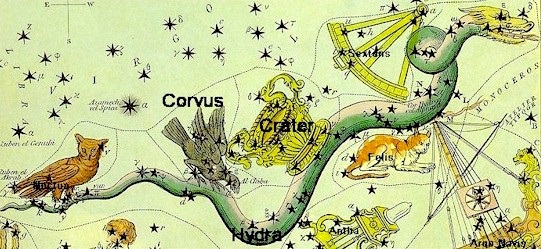
Scan the sky closely among all the dim stars in the sky and you will spot the constellation Crater. A small, faint constellation in the southern hemisphere, Crater is derived from the Latin word meaning ‘the cup’. One of the constellations first charted by the Greek astronomer Ptolemy in the 2nd century, it is located between Hydra and Leo, next to Corvus. A constellation from the Hercules family, it can be best seen sometime between March and June. Let us further discuss about this constellation.
Some of the notable stars in this constellation are:
- Labrum (Delta Crateris): It is basically an orange giant and is about 196 light years away. Labrum has a visual magnitude of 3.56 and is the brightest star in Crater.
- Alkes (Alpha Crateris): It is basically a class K1 orange giant which is about 174 light years away from the earth. Alkes has a visual magnitude of 4.07 and is about 80 times more luminous than the sun.
- Al Sharasif (Beta Crateris): It is basically a white sub giant. With a visual magnitude of 4.48, it is about 266 light years away from the solar system.
- y Crateris (Gamma Crateris): It is the second brightest star in the constellation. y Crateris is basically a close binary star about 84 light years away.
- SZ Crateris: In this constellation, SZ Crateris is basically a variable star, about 42.9 light years away from the earth. Its visual magnitude usually varies between 8.61 and 11.0.
- R Crateris: It is basically a semi–regular variable star with a magnitude that varies between 9.8 and 11.2. R Crateris also has an optical period of 160 days.
The deep sky objects in Crater include:
- NGC 3887: It is basically an 11th magnitude barred spiral galaxy in the constellation. NGC 3887 has a visual magnitude of 10.7 and is about 69 million light years away.
- NGC 3511: It is basically a spiral galaxy in the constellation with a magnitude of about 11.1. NGC 3511 was discovered on December 21, 1786 by William Herschel.
- NGC 3513: It is also a spiral galaxy with a magnitude of about 12 and is about 46 million light years away from the earth.
- NGC 3981: NGC 3981 is a spiral galaxy in the Crater. It comprises of two wide spiral arms and has a magnitude of about 12. It is about 3’ in diameter and is 80 million light years away from the earth.
Crater lies in the second quadrant of the southern hemisphere and can be seen at latitudes between +65° and -90°.
It occupies about 282 square degrees of space, making it the 53rd constellation in the sky.
Crater is represented as the cup of the god Apollo which is usually depicted as a two–handled chalice. According to the myth, god Apollo performs a ritual and is about to make a sacrifice on the altar. He needs some water and hence, sends the raven to fetch some water in his cup. The bird, however, gets distracted by a fig tree and spends a few days feasting on the figs. On his return, the raven brings along a water snake (Hydra) as an excuse for being late. The god sees through his lies and casts the cup (Crater), the water snake (Hydra) and the raven (Corvus) into the sky.

Constellations such as Corvus, Hydra, Leo, Sextans and Virgo surround Crater.


